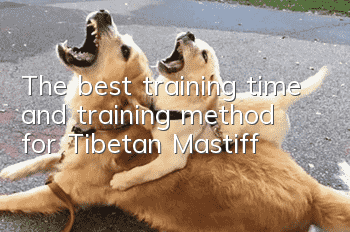The best training time and training method for Tibetan Mastiff

Regardless of whether it is a human or a dog, childhood is the best time for learning. Therefore, after the Tibetan Mastiff is weaned, we should start to systematically train it. In this case, the training can be easily completed.
Tibetan Mastiff
The ideal age for training Tibetan Mastiffs is 4 and a half months old, which is usually about one and a half months earlier than training wolf dogs (German Shepherds). The main reason is that Tibetan Mastiffs develop faster than wolf dogs, so the training age is relatively younger. To train an excellent Tibetan Mastiff, how to choose a young Mastiff is very important: first, it must be excited and lively; second, it must have a good appetite and courage; third, it must have good innate hunting ability and love to run and jump. If trained too early, the young mastiff has not yet formed a relatively stable personality, and may be timid or cowardly, or too lively and active, with an unprofessional expression, making it difficult to train. If trained too late, the Tibetan Mastiff will already have its own courage or personality, and the Tibetan Mastiff is a relatively stubborn breed, so it is difficult to adjust and train it.
However, some mastiff friends love their Tibetan Mastiffs so much that they are reluctant to tie them up and let the little Tibetan Mastiffs run wild. When they realize that they must be tied up, it is already very difficult. The little Tibetan Mastiff doesn't understand why the owner puts a collar or necklace on it, restricting its activities, jumping and barking. In the smallest case, it can break away from the collar or necklace, and in severe cases, the chain links are entangled around the body. The furious Tibetan Mastiff becomes more and more entangled, which is very easy to do. Hurt the body. This kind of thing only needs to happen once, and it will be difficult to tie the Tibetan Mastiff again in the future. Tethering training can be done by tying up the Tibetan Mastiff during feeding, and then feeding it. The Tibetan Mastiff will not adapt to it at first, but its desire to eat can alleviate the discomfort. After 2-3 consecutive days, the little Tibetan Mastiff will adapt to the tethering.
In addition, when allowing young mastiffs to receive obedience training, you should also pay attention to the following points:
1. Emotional cultivation: When training Tibetan Mastiff, you should first establish a close relationship with the little Tibetan Mastiff. For example, the owner should often come to the little Tibetan Mastiff and gently touch, pat the head, tickle, etc. The little Tibetan Mastiff will feel Very satisfying.
2. Traveling training: The owner can carry the chain lightly and use a combination of induction and mild coercion to lead him step by step. When the little Tibetan Mastiff can follow its owner for a few steps, praise or reward it with a little food in time.
3. Calling training: After reaching the point where the Tibetan Mastiff can be led freely, the calling training can be started. For this purpose, the traction chain can be lengthened, and along with the pulling, the Tibetan Mastiff can be called by name or summoned to come to the owner. The little Tibetan Mastiff's initial behavior of coming to its owner may not be due to the owner's call, but due to the completion of the instinct of attachment to the owner. But as long as the little Tibetan Mastiff can come to the owner's side, it should be rewarded in time, such as gently touching and praising a few words, the little Tibetan Mastiff will feel flattered and frightened. By repeating this process, the little Tibetan Mastiff will soon obey the owner's call.
- What to do if your dog has hypoglycemia
- When is the best time to train a junior dog, and what should you pay attention to when training?
- Symptoms and Treatment of Conjunctivitis in Dogs
- Pug Cold Symptoms and Treatments
- Why does a dog have soft and loose stools? Causes of soft and loose stools in dogs!
- Attention, poop shovelers! What are the things you need to pay attention to when raising a dog in spring?
- What are the reasons why dogs lose hair?
- How to clean indoors when you have pets?
- There is a peculiar smell in the dog’s ear canal, how to take care of the dog’s ear canal?
- Why does my dog vomit after taking a bath?



